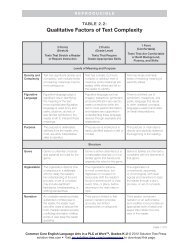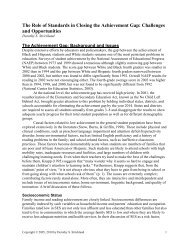Global Education Digest 2012 - International Reading Association
Global Education Digest 2012 - International Reading Association
Global Education Digest 2012 - International Reading Association
Create successful ePaper yourself
Turn your PDF publications into a flip-book with our unique Google optimized e-Paper software.
SECTION 2 / Learning achievement: Differing policies and practices regarding grade repetition<br />
Since 1999, the following countries reduced their<br />
repetition rates by at least 10 percentage points<br />
at the lower secondary education level: Eritrea,<br />
Mozambique, Sao Tome and Principe, and Zambia.<br />
However, there was a significant rise in rates in<br />
Lesotho, Namibia and Togo over the same period.<br />
In most cases, countries with high repetition rates at<br />
the lower secondary level (over 20%) tend to have<br />
rates exceeding 20% at the primary level, with the<br />
exceptions of Burkina Faso, Cape Verde, Niger, and<br />
Sao Tome and Principe.<br />
In general, boys are slightly more likely to repeat<br />
lower secondary grades than girls in most countries<br />
of sub-Saharan Africa. However, the gender gap<br />
was significant in Burkina Faso, where 31% of boys<br />
repeated a grade compared to 20% of girls in 2009,<br />
as well as in Angola and Cape Verde (6 versus 5<br />
percentage points respectively).<br />
South and West Asia: Small signs of progress,<br />
especially in Nepal and Bhutan<br />
The South and West Asia region has the second<br />
highest regional share – 28% – of the global<br />
population of primary education repeaters. Across<br />
the region, 9.1 million pupils at this education level<br />
repeated a grade in 2009. The good news is that the<br />
situation is improving, although at a slower rate than<br />
in sub-Saharan Africa. Between 2000 and 2010, the<br />
percentage of repeaters across the region remained<br />
the same at about 5%, even though the number<br />
of primary education pupils increased with rising<br />
enrolment.<br />
In contrast, repetition rates have increased in<br />
Bangladesh (from 11% to 13%) and Pakistan (from<br />
3% to 4%). This means that the number of children<br />
repeating a primary grade has risen by about 0.5<br />
million since 1999 in both countries combined.<br />
Overall, in the region, boys and girls are just as likely<br />
to repeat a grade of primary education.<br />
At the lower secondary level, repetition rates have<br />
been steadily falling in most countries in South and<br />
West Asia since 1999. The largest decreases were<br />
noticed in Bhutan (from 15% to 4%) and Iran (from<br />
13% to 4%). In general, gender is not a major issue<br />
affecting repetition rates.<br />
Latin America and the Caribbean: Repetition<br />
rates still high but some policy interventions<br />
show promise<br />
Repetition is also a major concern for the Latin<br />
America and Caribbean region, which accounts<br />
for 17% of the world’s primary education repeaters<br />
(see Figure 11). Yet, once again, the situation has<br />
been improving, with the regional percentage of<br />
repeaters falling from 12% to 8% between 2000<br />
and 2010. Unlike the previously described regions,<br />
the absolute number of repeaters in Latin America<br />
and the Caribbean has decreased from 8.4 million<br />
to 5.4 million over the same period. While this is<br />
partly due to a corresponding decline in primary<br />
school enrolment, the significant drop in the number<br />
of repeaters appears to reflect the success of<br />
interventions designed to reduce repetition (which<br />
are further discussed in Section 5).<br />
As shown in Figure 10, repetition rates at the<br />
primary education level decreased in four countries<br />
in South and West Asia, with significant progress<br />
made in Nepal, where the rates fell from 26% to<br />
12% between 1999 and 2009, followed by Bhutan<br />
(from 14% to 6%) and Iran (from 5% to 2%). In<br />
India, a slight drop in the repetition rate (from 4.3%<br />
to 3.5%) 5 has nevertheless led to a significant<br />
drop in the number of pupils repeating a grade.<br />
At the country level, repetition rates have fallen<br />
since 1999 in most countries of the region. The<br />
greatest progress has been made in Brazil, where<br />
the rate fell from 24% to 18% 6 , and in Saint Vincent<br />
and the Grenadines (10% to 4%). In contrast, there<br />
has been a significant rise in the repetition rate in<br />
Nicaragua, from 5% to 11%, as well as increases<br />
of about 2 to 4 percentage points in the Bahamas,<br />
5 The reference year is 2007.<br />
6 The reference year is 2004.<br />
24

















